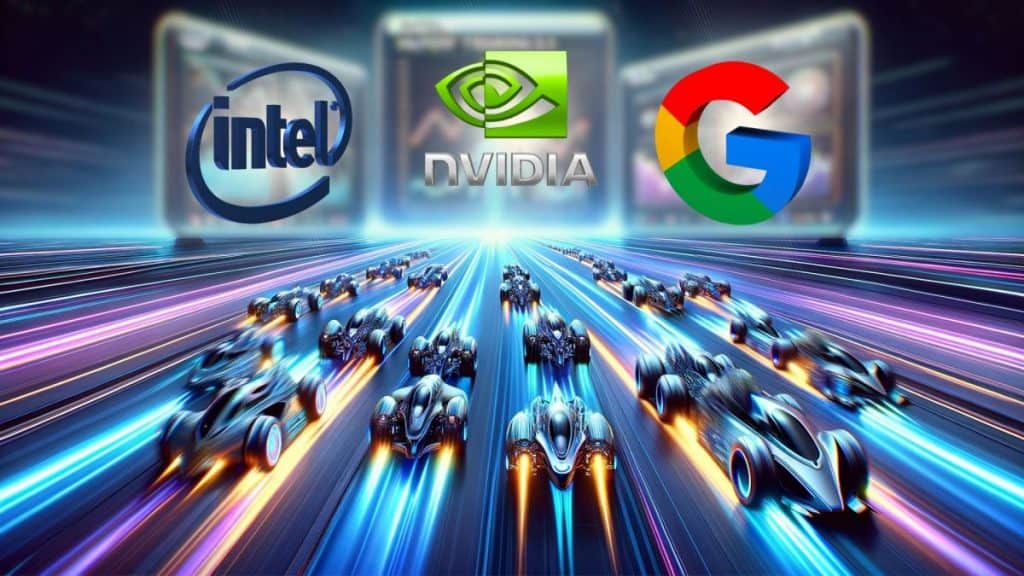MLPerf’s Training Benchmark Report Reveals Nvidia, Intel and Google Racing for Generative AI Dominance


In Brief
The recent MLPerf Training 3.1 benchmark report has provided a brief look into the intense AI competition among Nvidia, Intel and Google.

The field of artificial intelligence (AI) is undergoing a seismic shift, and major players such as Nvidia, Intel and Google are racing to be at the forefront of this revolution.
The recent MLPerf Training 3.1 benchmarks have provided a brief look into the intense competition among these tech giants, showcasing unprecedented gains in large language model (LLM) training.
In the first quarter of 2023, Nvidia, Intel and Google unveiled their AI neural-network systems for deep learning tasks. By the end of the year, the report shows that the companies have administered tests to demonstrate their levels of achievement.
The MLPerf benchmarks have recently become a battleground for demonstrating advancements in LLM training. Previously dominated by Moore’s Law predictions, the AI industry is now scaling hardware and software at a pace that outstrips traditional projections.
A number of experts claim that Moore’s Law is slowly coming to naught, so new discoveries by Nvidia, Intel and Google are likely expected to come in handy.
Nvidia’s EOS Supercomputer Dominance
Nvidia, a stalwart in the AI landscape, recently unveiled its EOS supercomputer, a technological marvel with 10,752 GPUs connected via Nvidia Quantum-2 InfiniBand. In the MLPerf Training 3.1 benchmarks, Nvidia achieved a staggering 2.8 times improvement in LLM training speed for its GPT-3 model since June.
The tasks included summarization, translation, classification and generation of new content such as computer code, marketing copy, poetry and more.
The EOS system’s mind-blowing specifications, including over 40 exaflops of AI compute, underscore Nvidia’s commitment to pushing the boundaries of AI.
Intel’s Gaudi 2 Accelerator Breakthrough
Intel made significant strides with its Habana Gaudi 2 accelerator, leveraging a combination of techniques, including the use of 8-bit floating point (FP8) data types.
The results speak for themselves, with a remarkable 103% training speed performance boost over the June MLPerf benchmarks. Intel’s strategic focus on price-performance metrics positions it as a formidable competitor in the AI training landscape.
“We projected a 90 percent gain from switching on FP8”, said Eitan Medina, chief operating officer at Intel’s Habana Labs. “We delivered more than what was promised—a 103 percent reduction in time-to-train for a 384-accelerator cluster.”
Google’s Cloud TPU v5e and Scaling Capabilities
Likewise, Google with its Cloud TPU v5e, has entered the competition showcasing its scaling capabilities. Utilizing FP8 for optimal training performance, Google highlighted its multislice scaling technology, enabling impressive scaling up to 1,024 nodes with 4,096 TPU v5e chips.
Google’s commitment to efficient scaling currently positions it as a key player in the race for AI dominance, since the company never stops optimizing its software.
The intense competition among Nvidia, Intel, and Google in the AI training arena is reshaping the future of artificial intelligence. As they push the boundaries of LLM training, these tech giants are not only exceeding Moore’s Law predictions but also propelling the industry into uncharted territories.
The outcomes of this competition will undoubtedly influence the trajectory of AI development and pave the way for transformative advancements in the field.
Disclaimer
In line with the Trust Project guidelines, please note that the information provided on this page is not intended to be and should not be interpreted as legal, tax, investment, financial, or any other form of advice. It is important to only invest what you can afford to lose and to seek independent financial advice if you have any doubts. For further information, we suggest referring to the terms and conditions as well as the help and support pages provided by the issuer or advertiser. MetaversePost is committed to accurate, unbiased reporting, but market conditions are subject to change without notice.
About The Author
Anya is a seasoned IT writer with a passion for exploring cutting-edge topics in the tech industry, including generative AI, Web3 gamification, and large language models (LLMs). Holding a degree in interpretation, she possesses a unique blend of linguistic expertise and technical acumen. Her inquiring mind and extensive experience allow her to navigate the ever-evolving landscape of technological innovation. Anya is dedicated to uncovering insights and trends across diverse language segments of the Internet, bringing a visionary perspective to her work. Through her articles, she aims to bridge the gap between complex IT concepts and a global audience, making technology accessible and engaging for readers worldwide.
More articles

Anya is a seasoned IT writer with a passion for exploring cutting-edge topics in the tech industry, including generative AI, Web3 gamification, and large language models (LLMs). Holding a degree in interpretation, she possesses a unique blend of linguistic expertise and technical acumen. Her inquiring mind and extensive experience allow her to navigate the ever-evolving landscape of technological innovation. Anya is dedicated to uncovering insights and trends across diverse language segments of the Internet, bringing a visionary perspective to her work. Through her articles, she aims to bridge the gap between complex IT concepts and a global audience, making technology accessible and engaging for readers worldwide.





















































